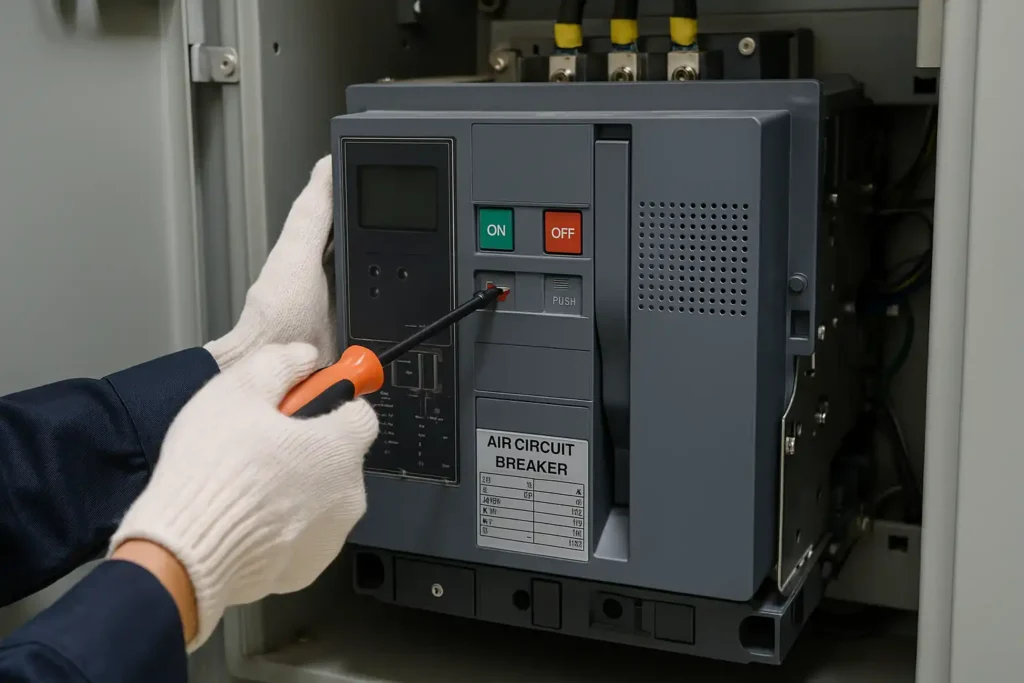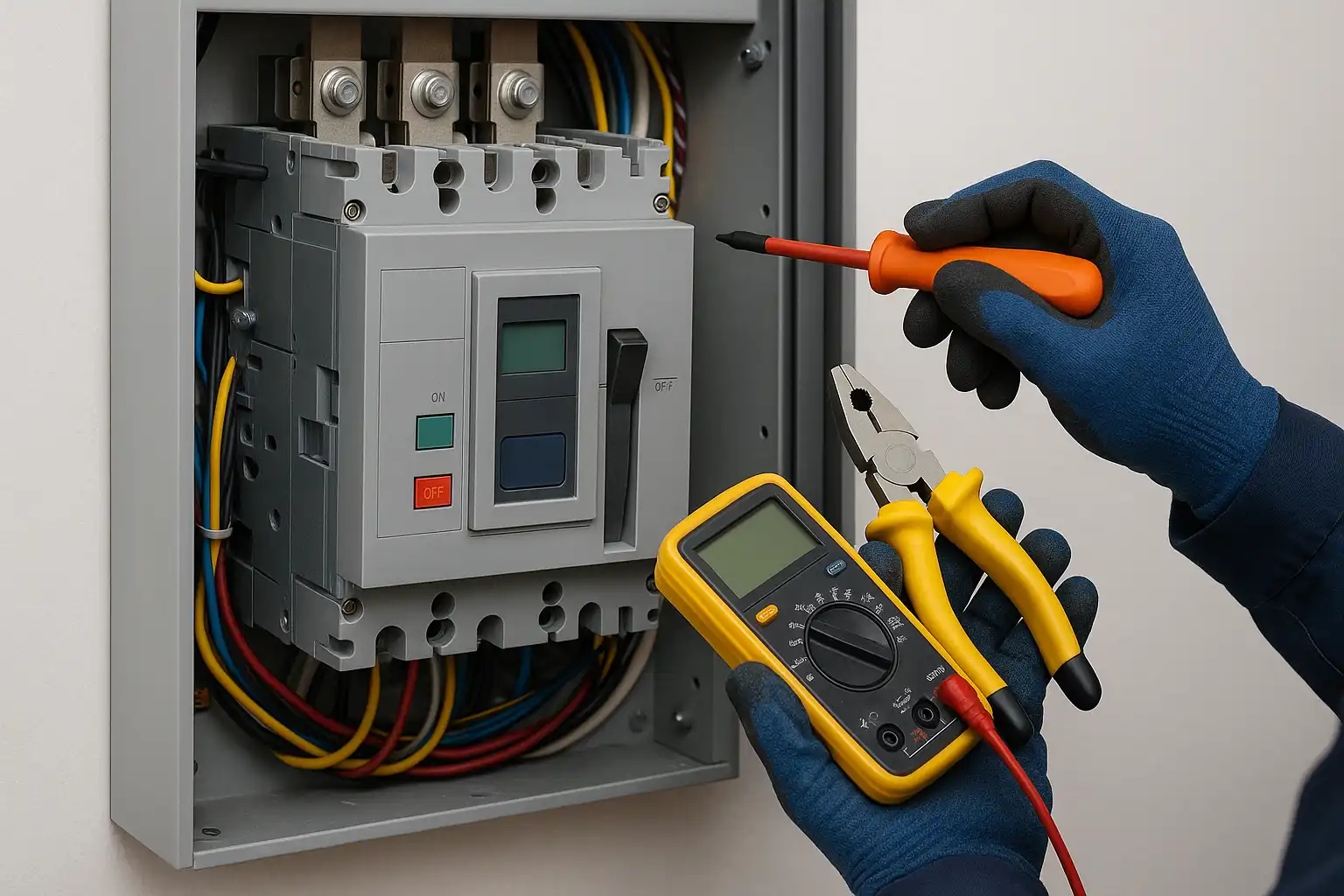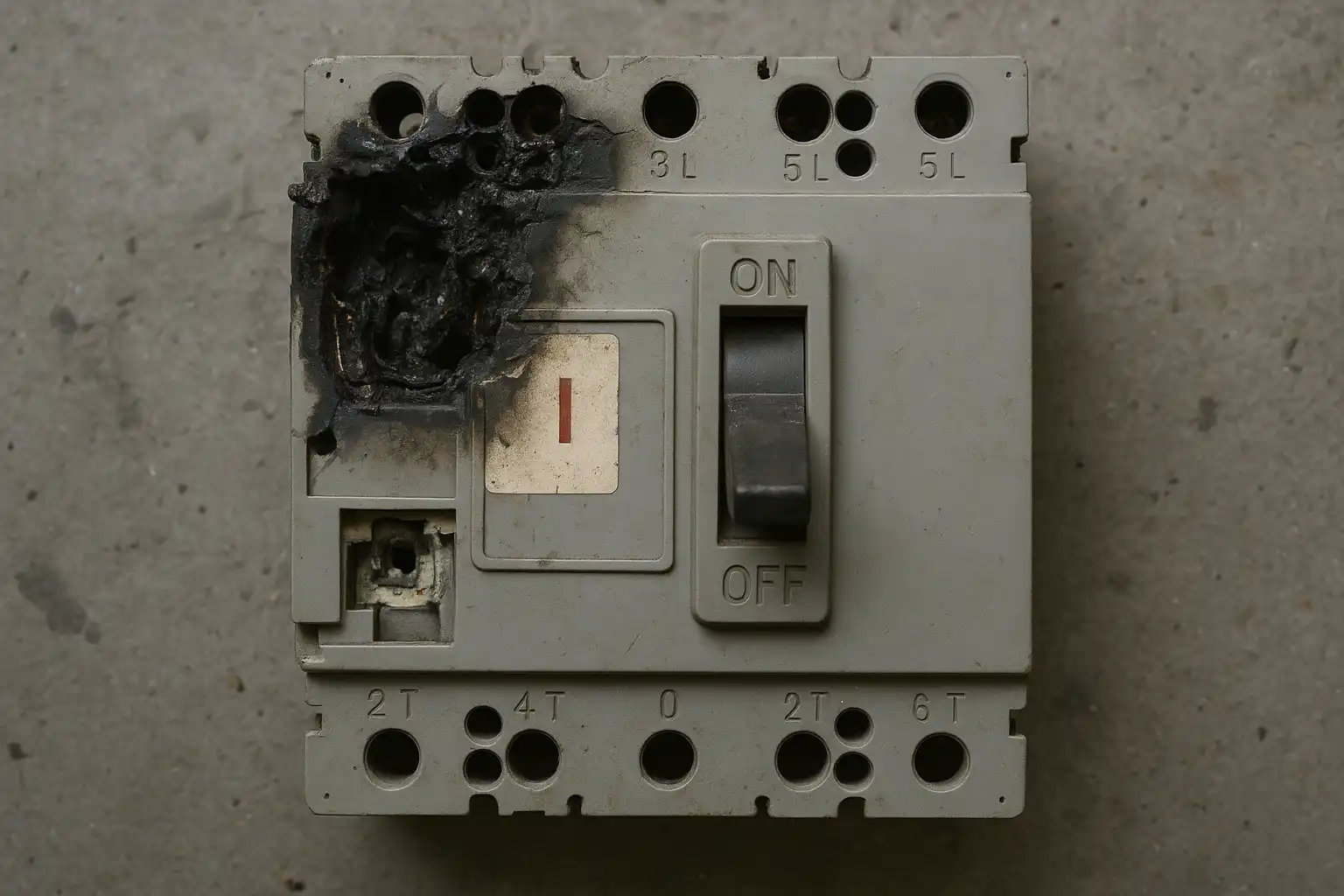-
The maintenance of air circuit breakers is essential for keeping electricity safe and steady.
-
Regular maintenance of air circuit breakers lowers the chance of failure to almost zero.
-
These breakers are expected to grow in value worldwide, from $235 million in 2025 to $420 million by 2033.
-
The maintenance of air circuit breakers, which includes cleaning, checking, and testing them, often prevents expensive problems.
-
This practice also helps them last longer and work better.
Key Takeaways
-
Taking care of air circuit breakers is important for safety. It helps lower the chance of them breaking down.
-
Use basic tools like multimeters and insulation testers to check and fix air circuit breakers.
-
Always stay safe by wearing safety gear and following rules during maintenance.
-
Follow a regular schedule to avoid problems and make air circuit breakers last longer.
-
Get training and certification to improve skills and safely handle new air circuit breakers.
Tools and Equipment for Circuit Breaker Maintenance
Essential Tools for Maintenance of Air Circuit Breakers
Having the right tools is important for maintaining air circuit breakers. These tools help you check, clean, and test the breaker parts. A basic set of tools should include:
-
Screwdrivers and wrenches: Tighten or loosen screws and bolts easily.
-
Multimeter: Measures voltage, current, and resistance to find problems.
-
Torque wrench: Ensures bolts are tightened with the correct force.
-
Insulation tester: Checks if the breaker’s insulation is working well.
-
Contact resistance meter: Tests electrical contacts to ensure proper function.
Advanced tools, like monitoring systems, can improve maintenance. These systems collect data and analyze the breaker’s condition automatically. This makes work faster and lowers the chance of failure.
Safety Gear and Precautions for Maintenance
Safety is the most important part of breaker maintenance. Electrical systems can be risky, so wear protective gear. Key safety items include:
-
Insulated gloves: Keep your hands safe from electric shocks.
-
Safety goggles: Protect your eyes from sparks or flying debris.
-
Hard hats: Shield your head from falling objects.
-
Rubber-soled boots: Help prevent electrical grounding accidents.
For every 100,000 electricians, ten lose their lives on the job. Many accidents happen due to unsafe actions or conditions. Wearing safety gear lowers your risk of injury. Always follow safety rules and turn off the breaker before working.
Recommended Cleaning and Testing Equipment
Cleaning and testing are key steps to keep breakers safe and efficient. Use these tools for the job:
|
Equipment Type |
Description |
|---|---|
|
Use water spray, steam, or cryogenic cleaning to remove dirt. |
|
|
High-Potential Test |
Tests insulation but not for regular use. |
|
Surge or Impulse Test |
Finds insulation faults by comparing waveforms. |
|
Infrared Inspection |
Spots heat issues and failures every three years. |
These tools meet technical standards and work well for breaker care. For instance, infrared inspections find heat problems early, helping you fix them before they worsen.
Step-by-Step Maintenance of Air Circuit Breakers
Visual Inspection of Components
Begin by carefully checking the breaker for visible problems. This step helps find damage before doing electrical tests. Look for signs like wear, burning marks, or overheating on parts.
Important areas to check include:
-
Contacts: See if there are burn marks or small holes.
-
Insulation: Check for cracks or damage that may cause issues.
-
Mechanisms and Safety Interlocks: Make sure they work well and aren’t worn out.
Visual checks ensure the breaker is set up right and not damaged. They also show if fixes are needed without extra testing. For instance, timing checks can spot early mechanical problems.
Tip: Always check visually before doing electrical tests. Fixing visible problems first saves time later.
Cleaning and Lubricating Moving Parts
Dust and dirt can make breakers work poorly. Cleaning and oiling moving parts is very important. Focus on the main contacts, arc chutes, and moving pieces.
Steps for cleaning:
-
Wipe dust off with a dry cloth or air spray.
-
For tough dirt, use a cleaner suggested by the maker.
-
Don’t use water or strong chemicals that might harm parts.
After cleaning, add oil to moving parts to stop wear. Use special oil made for electrical tools. Don’t use too much oil, as it can attract dirt.
Regular cleaning and oiling stop overheating and keep things working smoothly. This also helps the breaker last longer.
Note: Always turn off the breaker and unplug it before cleaning or oiling.
Contact Inspection and Testing
The contacts are key to how the breaker works. Checking and testing them ensures they handle electricity safely.
Steps for contact checks and tests:
-
Check Contacts: Look for burn marks, wear, or parts out of place. Replace bad contacts right away.
-
Test Contact Resistance: Use a meter to measure voltage drop. Compare it to the maker’s guide.
-
Do Timing Tests: Check how fast the contacts open and close. Make sure the movement is correct.
-
Test Control Circuits: Check the trip and close coil currents to meet standards.
These tests make sure the breaker works well under load. They also help find problems early before they cause failures.
Pro Tip: Write down your test results. This helps track how the breaker works over time and plan future fixes.
Insulation Resistance Testing
Testing insulation resistance is an important part of keeping air circuit breakers safe. It checks if the insulation inside the breaker stops electricity from leaking or causing short circuits. This test helps find problems early and prevents system failures.
Steps to do the test:
-
Use an insulation tester to measure resistance between metal parts and insulation.
-
Follow the maker’s guide for the right test voltage to avoid damage.
-
Write down the resistance value and compare it to the safe range in the manual.
High resistance means the insulation is working well. Low resistance shows issues like dirt, water, or old insulation. Testing regularly keeps your electrical system safe and reliable.
Tip: Always turn off the breaker before testing. This keeps you safe from electric shocks.
Mechanical and Electrical Performance Testing
Mechanical and electrical tests check how well the air circuit breaker works during normal use and faults. These tests make sure the breaker protects your system from damage.
Important Things to Test:
-
Contact Timing: Check when the breaker’s contacts open or close. This ensures they work on time and avoid system problems.
-
Mechanical Movement: Test how fast and smooth the breaker’s parts move. This prevents wear and keeps the breaker working well.
-
Control Circuits: Make sure the electronic coils that control the breaker work properly. Bad coils can harm the power system during faults.
-
Dynamic Resistance: Measure how the contacts perform while the breaker is working. This shows if they are reliable over time.
How to do the tests:
-
Use a contact resistance meter to check voltage drop across the contacts.
-
Test timing to see how quickly the breaker reacts to commands.
-
Check control circuits to ensure trip and close coils work correctly.
-
Save all test results and compare them to the maker’s standards.
These tests help find and fix problems early. They keep the breaker’s parts working well, extend its life, and protect your system.
Pro Tip: Keep a record of test results. This helps track how the breaker works and plan future maintenance.
Common Issues and Troubleshooting in Circuit Breaker Maintenance
Finding Common Problems (e.g., overheating, wear, and tear)
Air circuit breakers can have problems like overheating or wearing out. Overheating happens when dirt builds up or contacts wear down. This can damage insulation or even cause fires. Moving parts wear out faster if they aren’t oiled. Cracks in insulation or burnt marks on contacts are warning signs. These show the breaker isn’t working well.
Regular maintenance helps find these problems early. Cleaning and oiling parts stop overheating and reduce wear. Always check the breaker to spot issues before they get worse.
Fixing Electrical Problems
Electrical problems in air circuit breakers can cause system issues. Breakers may not open or close properly. For example, old grease or no oil can stop them from opening. Worn-out parts can also make them fail during use.
To fix these problems, compare test results and reports. The table below shows common failures and their causes:
|
Failure Type |
Description |
|---|---|
|
Failure to Open |
A 4160 Vac breaker didn’t open due to old grease and no oil. Maintenance was skipped even after past failures. |
|
Failure to Close |
Some breakers were too worn out to work right. |
|
Common-Cause Failures |
Data from 1980–2000 shows why breakers fail and how to prevent it. |
Use this information to find the problem and fix it.
Fixing Mechanical Problems
Mechanical problems happen when parts wear out or are not adjusted right. You might see slow movements or parts not lining up. These problems can stop the breaker from protecting your system.
To fix mechanical problems, check all moving parts. Replace worn-out pieces and align them correctly. Oil the moving parts to make them work smoothly again. Test the breaker after fixing it to ensure it works properly.
Fixing mechanical problems quickly helps the breaker last longer and keeps your system safe.
Best Practices for Maintenance of Air Circuit Breakers in 2025
Adjusting to New Air Circuit Breaker Features
Modern air circuit breakers (ACBs) in 2025 have advanced features. These updates make maintenance easier and reduce downtime. Many ACBs now include systems that monitor load currents and fault histories. These systems help spot problems early and improve reliability.
Key features of modern ACBs:
-
Easier access for cleaning and repairs.
-
Faster inspections and part replacements.
-
Designs that save time in busy environments.
|
Key Feature |
Description |
|---|---|
|
Integrated Metering and Monitoring |
Tracks load currents and fault histories continuously. |
|
Predictive Maintenance Strategies |
Replaces parts before they fail completely. |
Knowing these features helps you adjust your maintenance plan. This ensures the breaker works well and lasts longer.
Using High-Tech Diagnostic Tools
New diagnostic tools make checking air circuit breakers faster and easier. These tools find problems without taking the breaker apart. For example, NASA used X-ray imaging to inspect 26 breakers. They found that 19 didn’t need internal repairs, showing the value of non-invasive methods.
Benefits of advanced tools:
-
Less need for difficult inspections.
-
Better safety and reliability.
-
Saves time and money during maintenance.
Using these tools helps you catch issues early. This keeps the breaker working without long delays.
Planning Regular Maintenance Times
Preventive maintenance keeps air circuit breakers working well. Scheduling regular checks avoids sudden failures and extends their life. There are three main types of preventive maintenance:
|
Type of Maintenance |
Description |
|---|---|
|
Time-Based Maintenance (TBM) |
Done at set times, good for predictable wear. |
|
Usage-Based Maintenance (UBM) |
Based on how often the breaker is used. |
|
Condition-Based Maintenance (CBM) |
Uses real-time data to find problems before they cause damage. |
Choose the best strategy for your system. For example, condition-based maintenance uses live data to prevent issues. This method reduces downtime and keeps the breaker running smoothly. Regular checks keep your system safe and reliable.
Tip: Write down your maintenance schedule and results. This helps you plan future tasks and track performance.
Training and Certification for Maintenance Personnel
Learning and earning certifications help you work on air circuit breakers safely. Training teaches you how to handle modern designs and advanced tools.
Why Training Is Important
Air circuit breakers are tricky to work with. Without training, you might break them or cause danger. Training helps you:
-
Know the parts and how air circuit breakers work.
-
Use tools like insulation testers and infrared scanners correctly.
-
Follow safety rules to avoid accidents.
Tip: Pick training programs with both lessons and hands-on practice. This prepares you for real-life tasks.
Why Certification Helps
Certification shows you’re skilled at maintaining air circuit breakers. It also improves your job chances. Employers trust certified workers to do the job right.
Popular certifications include:
-
Certified Electrical Maintenance Technician (CEMT)
-
National Institute for Certification in Engineering Technologies (NICET)
-
Electrical Safety Compliance Professional (ESCP)
Steps to Get Certified
Here’s how to earn your certification:
-
Join a training program from a trusted institution.
-
Learn safety rules and maintenance methods from the course.
-
Pass tests to show your knowledge and skills.
Pro Tip: Take refresher courses to keep your certification current. This helps you stay updated on new tools and methods.
Training and certification improve your skills and keep systems safe and reliable.
Taking care of air circuit breakers keeps them safe and working well. Using proper tools and steps stops big problems and helps them last longer. Fixing issues quickly during maintenance keeps everything running smoothly.
Make a plan for regular maintenance that fits your needs. For hard tasks, ask experts to ensure the best results. This not only protects your system but also saves time and money over time.
Tip: Write down all maintenance work. This helps you check how things are working and plan future checks easily.
FAQ
What is the most important step in air circuit breaker maintenance?
Regular checks are the most important step. They help find damage, wear, or overheating early. Fixing these problems quickly keeps the breaker working well.
Tip: Look at the breaker first before doing electrical tests.
How often should you perform maintenance on air circuit breakers?
Do maintenance at least once every year. If the system is used a lot, check it more often. Regular care keeps the breaker safe and lasts longer.
Note: Follow the maker’s advice for how often to do checks.
Can you clean air circuit breakers without professional help?
Yes, you can clean them safely by following rules. Use a dry cloth or air spray for dust. Don’t use water or strong cleaners. Always turn off the breaker first.
Warning: For hard problems, ask a trained technician for help.
What tools are essential for testing air circuit breakers?
You need tools like a multimeter, insulation tester, and contact resistance meter. These tools check voltage, resistance, and contact performance.
Pro Tip: Get advanced tools for faster and better testing results.
Why is training important for air circuit breaker maintenance?
Training teaches you how to handle modern breakers and tools safely. It also helps you avoid mistakes during maintenance.
Emoji Reminder: 🛠️ Training with certification improves skills and job chances.
The following information may be of interest to you
High quality air circuit breaker
Application and advantages of air circuit breakers
Comprehensive guide for wiring methods of air circuit breakers





